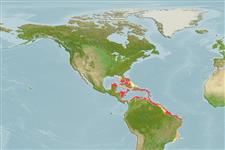Environment: milieu / climate zone / depth range / distribution range
Écologie
marin récifal; profondeur 0 - 85 m (Ref. 9626), usually 5 - 30 m (Ref. 9626). Tropical; 28°N - 25°S, 91°W - 31°W
Western Atlantic: Bahamas to Brazil, including the southern part of the Gulf of Mexico and throughout the Caribbean Sea.
Taille / Poids / Âge
Maturity: Lm ? range ? - ? cm
Max length : 37.0 cm TL mâle / non sexé; (Ref. 26340); common length : 30.0 cm TL mâle / non sexé; (Ref. 3815)
Épines dorsales (Total): 12; Rayons mous dorsaux (Total): 12; Épines anales 3; Rayons mous anaux: 10. Dorsal profile of head moderately steep; prefrontal tubercle not well developed; silvery with a lavender iridescence, the edges of the scales brownish yellow and the centers with a vertically elongate iridescent blue-green or blue spot (Ref. 13442).
Adults often seen over rocky areas or reefs, but also on flat bottoms to about 85 m depth, while the young inhabit shallower waters (Ref. 3815). Feeds on crabs, mollusks, worms, brittle stars and hermit crabs (Ref. 3815). This is the most common species of the genus in the Antilles (Ref. 3815). Important food fish (Ref. 3815).
Life cycle and mating behavior
Maturité | Reproduction | Frai | Œufs | Fécondité | Larves
Cervigón, F., 1993. Los peces marinos de Venezuela. Volume 2. Fundación Científica Los Roques, Caracas,Venezuela. 497 p. (Ref. 9626)
Statut dans la liste rouge de l'IUCN (Ref. 130435)
Menace pour l'homme
Reports of ciguatera poisoning (Ref. 30303)
Utilisations par l'homme
Pêcheries: commercial
Plus d'informations
Noms communsSynonymesMétabolismePrédateursÉcotoxicologieReproductionMaturitéFraiRassemblement de ponteFéconditéŒufsDéveloppement de l'œuf
RéférencesAquacultureProfil d'aquacultureSouchesGénétiqueElectrophoresesHéritabilitéPathologiesTraitementNutrientsMass conversion
Outils
Articles particuliers
Télécharger en XML
Sources Internet
Estimates based on models
Preferred temperature (Ref.
123201): 25.4 - 28, mean 27.3 °C (based on 212 cells).
Phylogenetic diversity index (Ref.
82804): PD
50 = 0.5001 [Uniqueness, from 0.5 = low to 2.0 = high].
Bayesian length-weight: a=0.01950 (0.01248 - 0.03045), b=2.95 (2.82 - 3.08), in cm total length, based on LWR estimates for this species & Genus-body shape (Ref.
93245).
Niveau trophique (Ref.
69278): 3.7 ±0.2 se; based on diet studies.
Résilience (Ref.
120179): Milieu, temps minimum de doublement de population : 1,4 à 4,4 années (Preliminary K or Fecundity.).
Fishing Vulnerability (Ref.
59153): Low to moderate vulnerability (27 of 100).
Nutrients (Ref.
124155): Calcium = 45.5 [21.0, 91.8] mg/100g; Iron = 0.561 [0.298, 1.114] mg/100g; Protein = 19.3 [18.0, 20.7] %; Omega3 = 0.124 [0.075, 0.208] g/100g; Selenium = 33.9 [17.7, 64.2] μg/100g; VitaminA = 58.9 [14.9, 219.9] μg/100g; Zinc = 0.977 [0.631, 1.411] mg/100g (wet weight);
